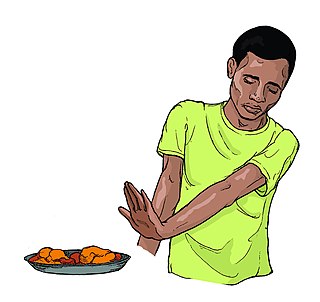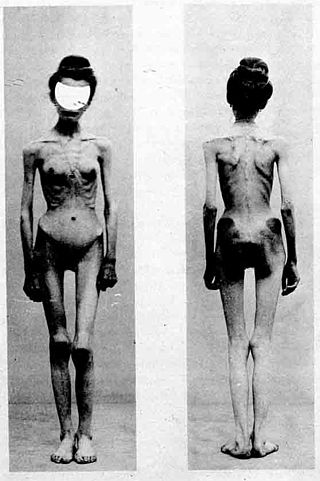Overview
The overweight person swapped diets with the underweight person. While the underweight person was suddenly given more food than they would usually eat in a few days at one meal, the overweight person was usually given tea, coffee, a small snack, or nothing sometimes. Most of the underweight people were unable to finish their meal, though occasionally the overweight people also refused or struggled to eat their meals, usually after having been in the feeding clinic for a few days. Occasionally both were allowed to leave the feeding clinic for a meal swap, if it was part of both of the participants' diets.
In earlier series, the show featured a food tube for each person. The tube contained what each person ate and drank in the span of one week.
Usually Dr Jessen used shock tactics to demonstrate how poor someone's diet was. Both participants were occasionally shown the extent of their poor diet - for example, through bags of sugar. The "superskinny" would usually be shown pictures of their body and be told about the drastic long-term health effects. In the second series, the "supersizer" was sent to meet a woman named Lisa, whose obesity had meant that she could no longer care for herself and was receiving an operation because of her weight. In later series, the "supersizer" was sent to the United States to visit someone that was heavier than they were. It was used as a shock tactic to show the "supersizer" what they could become if they did not stop their unhealthy lifestyles.
The show also featured Anna Richardson in the 1st, 2nd, and 3rd series, who in the first series examined new methods to lose weight by trying diets she found on the Internet, some of which had shocking side effects. For example, Anna attempted Laser lipolysis , which went drastically wrong and resulted in severe bruising. Also, she discovered Diabulimia and spoke to Isabelle Caro, a French actress, renowned for her underweight figure and anorexia campaign. In the second series, Anna recruited a group of "flab-fighters" - women who wanted to lose weight and whose weight was tracked weekly - and she visited Los Angeles to discover ways A-listers would lose weight. The same series also saw a group of four anorexic women attempt to overcome their eating disorder through eating and preparing foods they would usually avoid with the help of a leading eating disorder specialist. In later series, formerly anorexic journalist Emma Wolf interviewed a number of people who had experienced the effects of eating disorders.
The second, third and fourth series also introduced a section whereby a group of people recovering from eating disorders (the second and third series featured people exclusively suffering from anorexia nervosa, while the fourth included a mixture of eating disorders) were overwatched by a specialist psychiatrist and dietician Ursula Philpot who co-presented Supersize vs Superskinny and who worked to challenge their issues with food.
During the first series in 2008, one feature involved Gillian McKeith, who tried to find a way to "ban big bums" in the UK. She tested out different exercises to tone the buttocks of different groups of ladies, and made a leader board for the most effective.

Anorexia is a medical term for a loss of appetite. While the term outside of the scientific literature is often used interchangeably with anorexia nervosa, many possible causes exist for a loss of appetite, some of which may be harmless, while others indicate a serious clinical condition or pose a significant risk.
An eating disorder is a mental disorder defined by abnormal eating behaviors that negatively affect a person's physical or mental health. Types of eating disorders include binge eating disorder, where the patient eats a large amount in a short period of time; anorexia nervosa, where the person has an intense fear of gaining weight and restricts food or overexercises to manage this fear; bulimia nervosa, where individuals eat a large quantity (binging) then try to rid themselves of the food (purging); pica, where the patient eats non-food items; rumination syndrome, where the patient regurgitates undigested or minimally digested food; avoidant/restrictive food intake disorder (ARFID), where people have a reduced or selective food intake due to some psychological reasons; and a group of other specified feeding or eating disorders. Anxiety disorders, depression and substance abuse are common among people with eating disorders. These disorders do not include obesity. People often experience comorbidity between an eating disorder and OCD. It is estimated 20–60% of patients with an ED have a history of OCD.
Fasting is the abstention from eating and sometimes drinking. From a purely physiological context, "fasting" may refer to the metabolic status of a person who has not eaten overnight, or to the metabolic state achieved after complete digestion and absorption of a meal. Metabolic changes in the fasting state begin after absorption of a meal.

Eating is the ingestion of food. In biology, this is typically done to provide a heterotrophic organism with energy and nutrients and to allow for growth. Animals and other heterotrophs must eat in order to survive — carnivores eat other animals, herbivores eat plants, omnivores consume a mixture of both plant and animal matter, and detritivores eat detritus. Fungi digest organic matter outside their bodies as opposed to animals that digest their food inside their bodies.
Orthorexia nervosa is a proposed eating disorder characterized by an excessive preoccupation with eating healthy food. The term was introduced in 1997 by American physician Steven Bratman, M.D. He suggested that some people's dietary restrictions intended to promote health may paradoxically lead to unhealthy consequences, such as social isolation; anxiety; loss of ability to eat in a natural, intuitive manner; reduced interest in the full range of other healthy human activities; and, in rare cases, severe malnutrition or even death.
Promotion of anorexia is the promotion of behaviors related to the eating disorder anorexia nervosa. It is often referred to simply as pro-ana or ana. The lesser-used term pro-mia refers likewise to bulimia nervosa and is sometimes used interchangeably with pro-ana. Pro-ana groups differ widely in their stances. Most claim that they exist mainly as a non-judgmental environment for anorexics; a place to turn to, to discuss their illness, and to support those who choose to enter recovery. Others deny anorexia nervosa is a mental illness and claim instead that it is a lifestyle choice that should be respected by doctors and family.

In nutrition, diet is the sum of food consumed by a person or other organism. The word diet often implies the use of specific intake of nutrition for health or weight-management reasons. Although humans are omnivores, each culture and each person holds some food preferences or some food taboos. This may be due to personal tastes or ethical reasons. Individual dietary choices may be more or less healthy.
Tracey Gold is an American actress and former child star known for playing Carol Seaver on the 1980s sitcom Growing Pains.

An underweight person is a person whose body weight is considered too low to be healthy. A person who is underweight is malnourished.

Sociology of the body is a branch of sociology studying the representations and social uses of the human body in modern societies.
"The American Dad After School Special" is the second episode of the third season and the twenty-fifth overall episode of the animated comedy series American Dad! It aired on Fox in the United States on September 17, 2006, and is written by Dan Vebber and directed by Pam Cooke.

Some claim that the history of anorexia nervosa begins with descriptions of religious fasting dating from the Hellenistic era and continuing into the medieval period. A number of well known historical figures, including Catherine of Siena and Mary, Queen of Scots are believed to have suffered from the condition. Others link the emergence of anorexia to the distinctive presence of an extreme fear of being overweight despite being underweight which emerged in the second half of the 19th century and was first observed by Jean Martin Charcot and other French psychiatrists at the Salpetrière
Avoidant/restrictive food intake disorder (ARFID) is a feeding or eating disorder in which people avoid eating certain foods, or restrict their diets to the point it ultimately results in nutritional deficiencies. This can be due to the sensory characteristics of food, such as its appearance, smell, texture, or taste; due to fear of negative consequences such as choking or vomiting; having little interest in eating or food, or a combination of these factors. People with ARFID may also be afraid of trying new foods, a fear known as food neophobia.
Wannarexia, or anorexic yearning, is a label applied to someone who claims to have anorexia nervosa, or wishes they did, but does not. These individuals are also called wannarexic, “wanna-be ana” or "anorexic wannabe". The neologism wannarexia is a portmanteau of the latter two terms. It may be used as a pejorative term.

Isabelle Caro Rosenbohm was a French model and actress from Marseille, France, who became well known after appearing in a controversial advertising campaign "No Anorexia" which showed Caro with vertebrae and facial bones showing under her skin in a picture by photographer Oliviero Toscani.

Thin is a 2006 cinéma vérité documentary film directed by Lauren Greenfield and distributed by HBO. It was filmed at The Renfrew Center of Florida in Coconut Creek, a 40-bed residential facility for the treatment of women with eating disorders. The center has been described as "one of the nation's best-known inpatient eating disorders centres". The film follows four women with anorexia nervosa, bulimia nervosa and other eating disorders in their struggle for recovery. The film premiered at the 2005 Sundance Film Festival in 2005, before premiering to the general public on November 14, 2006 on HBO.
Intermittent fasting is any of various meal timing schedules that cycle between voluntary fasting and non-fasting over a given period. Methods of intermittent fasting include alternate-day fasting, periodic fasting, such as the 5:2 diet, and daily time-restricted eating.

Anorexia nervosa (AN), often referred to simply as anorexia, is an eating disorder characterized by low weight, food restriction, body image disturbance, fear of gaining weight, and an overpowering desire to be thin.

Summer's Dream is a preteen/teen novel published in 2012 by Cathy Cassidy.
Atypical anorexia nervosa is an eating disorder in which individuals meet all the qualifications for anorexia nervosa, including a body image disturbance and a history of restrictive eating and weight loss, except that they are not currently underweight. Atypical anorexia qualifies as a mental health disorder in the Diagnostic and Statistical Manual of Mental Disorders (DSM-5), under the category Other Specified Feeding and Eating Disorders (OSFED). The characteristics of people with atypical anorexia generally do not differ significantly from anorexia nervosa patients except for their current weight.









